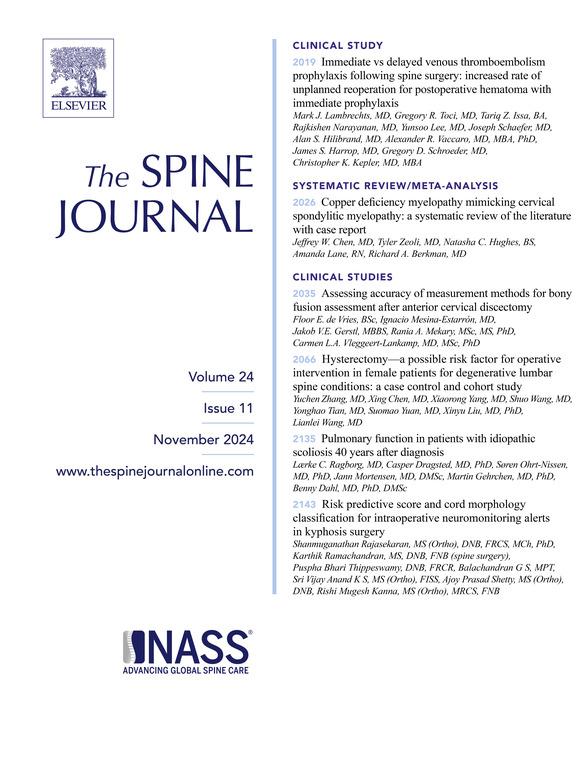45. FDA IDE减压和动态矢状系带稳定与减压和经椎间孔腰椎体间融合术的临床试验:恢复日常生活活动和残疾改善
IF 4.7
1区 医学
Q1 CLINICAL NEUROLOGY
引用次数: 0
摘要
背景背景退行性椎体滑脱(DS)合并腰椎管狭窄(LSS)通常采用减压融合治疗。一项研究性手术,脊椎成形术,包括直接手术减压和动态矢状系带(DST)稳定。手术的主要目的是缓解症状,使患者能够恢复工作和正常的日常生活活动。目的评估24个月时接受减压和DST稳定(腰椎成形术)与减压和经椎间孔腰椎体间融合术(D+TLIF)的恢复工作(RTW)和日常生活活动(ADL)。研究设计/背景:一项多中心、同时对照研究的中期分析。患者样本:接受I级Meyerding腰椎退行性滑移和LSS治疗(脊椎成形术或D+ tliff)的患者。采用倾向评分(PS)选择患者,随访24个月。恢复工作和日常生活活动的时间,Oswestry残疾指数(ODI), VAS背部疼痛和VAS腿/髋关节疼痛(最严重一侧)。方法采用sps选择的FDA IDE研究对象(NCT03115983),随访24个月。研究记录查询了术前和截至24个月的各个时间点的工作状态,以及到ADL和RTW的时间,以及24个月与术前相比的残疾变化(ODI, VAS背部和VAS腿/髋关节[最差一侧])。结果299名入组受试者中,287名采用ps -s方法(140例为脊椎成形术,147例为D+TLIF)。两组在疼痛和残疾方面均表现出显著的持久改善。椎管病组在随访6周和3个月时ODI明显降低(p < 0.05)。在24个月时,ODI、VAS背部疼痛或VAS唇/髋关节(最坏侧)方面各组间没有统计学差异,尽管脊椎成形术组在所有测量中都显示出更大的改善效果。患者报告的结果显示,与D+TLIF组相比,脊椎成形术组(术前工作的患者)在每个术后时间点的ADL和RTW恢复都更高。24个月时,脊椎成形术的ADL恢复率为95%,而D+TLIF为80%;脊椎成形术的RTW为90%,而D+TLIF的RTW为75%。结论手术治疗有症状退行性椎体滑移的主要目的是缓解症状,使患者恢复正常的生活自理和工作。在24个月的随访中,脊椎成形术和D+TLIF治疗的患者均显示残疾显著减少。脊椎成形术组恢复更快,包括术后立即残疾更低,RTW和ADL明显更快。对于有症状性退行性椎体滑移的患者,DST减压和稳定(椎体成形术)可能是腰椎融合术的一种微创替代方法。长期随访评估倾向得分调整后的结果将证明这种优势和长期结果是否持久和可推广。FDA器械/药物状态:limiflex动态矢状栓(研究/未批准)本文章由计算机程序翻译,如有差异,请以英文原文为准。
45. Return to work activities of daily living and disability improvement of an FDA IDE trial of decompression and dynamic sagittal tether stabilization versus decompression and transforaminal lumbar interbody fusion
BACKGROUND CONTEXT
Degenerative spondylolisthesis (DS) with lumbar spinal stenosis (LSS) is commonly treated with decompression and fusion. An investigational procedure, Spondyloplasty, incorporates direct surgical decompression and stabilization with a dynamic sagittal tether (DST). The primary objective of surgery is resolution of symptoms so patients can return to work and their normal activities of daily living.
PURPOSE
Assess return to work (RTW) and activities of daily living (ADL) receiving either decompression and DST stabilization (Spondyloplasty) compared to decompression and transforaminal lumbar interbody fusion (D+TLIF) at 24 months.
STUDY DESIGN/SETTING
Interim analysis from a multicenter, concurrently controlled study.
PATIENT SAMPLE
Patients undergoing treatment (Spondyloplasty or D+TLIF) of Grade I Meyerding lumbar DS and LSS. Propensity score (PS) selected patients with 24-month follow-up were included.
OUTCOME MEASURES
Time to return to work and activities of daily living, Oswestry disability index (ODI), VAS Back Pain and VAS Leg/Hip Pain (Worst Side).
METHODS
PS-selected FDA IDE study subjects (NCT03115983) with 24-months follow-up were included in this analysis. Study records queried for work status preoperatively and various time points up to 24 months, as well as time to ADL and RTW, and change in disability (ODI, VAS Back and VAS Leg/Hip [Worst Side]) at 24 months vs preoperatively.
RESULTS
Of 299 enrolled subjects, 287 were PS-selected (140= Spondyloplasty and 147= D+TLIF). Both groups demonstrated significant durable improvements in pain and disability. The Spondylopasty group had significantly lower ODI at 6-week and 3-month follow-ups (p<0.05). At 24 months, there were no statistical differences seen between groups in ODI, VAS Back Pain or VAS Lip/Hip (Worst Side), although the Spondyloplasty group demonstrated larger improvement effect sizes in all measures. The patient-reported outcomes showed the return to ADL and RTW (among patients working preoperatively) for the Spondyloplasty group was greater at every postoperative time point compared to the D+TLIF group. At 24 months, return to ADL was >95% for Spondyloplasty versus <80% for D+TLIF; and the RTW was >90% for Spondyloplasty versus < 75% D+TLIF.
CONCLUSIONS
The primary objective of surgery for symptomatic DS is resolution of symptoms so patients can return to their normal ADL and work. Both Spondyloplasty and D+TLIF treated patients demonstrated significant reductions in disability at 24-month follow-up. The Spondyloplasty group had quicker recovery, including lower disability at immediate postoperative intervals and significantly faster RTW and ADL. Decompression and stabilization with DST procedure (Spondyloplasty) may be a minimally invasive alternative to lumbar fusion for patients with symptomatic DS. Longer-term follow-up assessment with propensity score-adjusted outcomes will demonstrate whether this advantage and long-term outcomes are durable and generalizable.
FDA Device/Drug Status
LimiFlex Dynamic Sagittal Tether (Investigational/Not Approved)
求助全文
通过发布文献求助,成功后即可免费获取论文全文。
去求助
来源期刊

Spine Journal
医学-临床神经学
CiteScore
8.20
自引率
6.70%
发文量
680
审稿时长
13.1 weeks
期刊介绍:
The Spine Journal, the official journal of the North American Spine Society, is an international and multidisciplinary journal that publishes original, peer-reviewed articles on research and treatment related to the spine and spine care, including basic science and clinical investigations. It is a condition of publication that manuscripts submitted to The Spine Journal have not been published, and will not be simultaneously submitted or published elsewhere. The Spine Journal also publishes major reviews of specific topics by acknowledged authorities, technical notes, teaching editorials, and other special features, Letters to the Editor-in-Chief are encouraged.
 求助内容:
求助内容: 应助结果提醒方式:
应助结果提醒方式:


